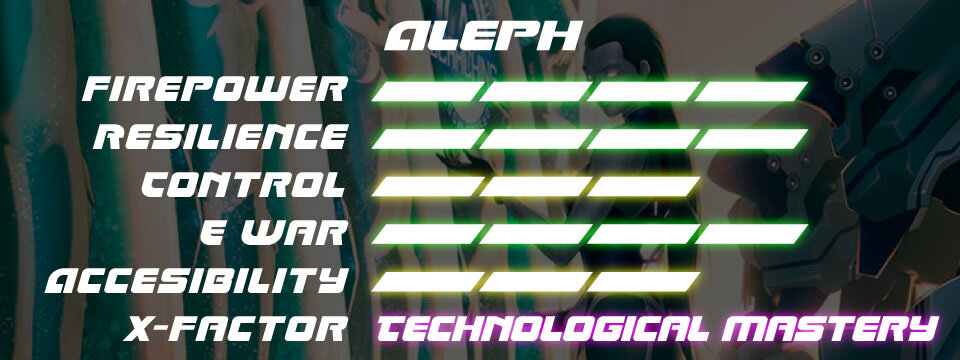Which Infinity Army is for You? Part 7: ALEPH
The last of what I’d consider the main stars of Infinity, ALEPH represent the most technologically advanced aspects of the Human Sphere. Engineered to defend against the worst threats space has to offer, while also providing a governing body and guidance to humanity. Is ALEPH a cybernetic benefactor, or are they here to enslave the human race to serve their own will? Depends who you ask!
Rating System
Instead of comparing one army to another, I’m going to rate armies based on how good of a match they are for new players interested in that particular category. For example, just about any army can make a hacking heavy list, but it may take more effort for some than others. An army which effortlessly competes in hacking would be given a 5, armies take considerable effort (if at all possible) would be a 1 or 2, while armies which could be tailored either way would be a 3.
Army Metrics
Firepower. This is probably the easiest to understand, which is why it comes first! This is the sheer ability for this army to win ranged firefights. While it is a good metric for offensive power, it doesn’t mean they’re going to punch everyone off the table every time.
Resilience. Like firepower, this is a fairly straight forward metric which expresses how much punishment an army could take. If a typical list for this army has access to a lot of high armor or multi-wound troops, they’ll have a higher Resilience score.
Control. Tempo is incredibly important in Infinity, the ability to control the ebb and flow of the game, which engagements happen and so on. Armies with high control tend to have better access to infiltration, camouflage, and other deployment skills, as well as troops which can rapidly change position on the table.
E War. A huge draw of Infinity is Hacking, E War represents any particular army’s ability to compete in the hacking arena. Do they have enough to get by, or can they build out a punishing hacking network to shut down the enemy?
Accessibility. This represents the difficulty for new players to pick up the army, learn the basics, and play effectively on the table. Some armies are easy to figure out at the beginning, while others have a lot of unique rules or require more advanced techniques to win.
X-Factor. Every army has a little something special about them, and if you’re debating between two armies, this could be the deciding factor.
What’s missing? If you’re coming from other game systems, you might expect to see how good an army is in close combat. Infinity is not most games, this is a game where bullets are lethal, and you don’t want to bring a knife to a gun fight. Some armies however are exceptionally good in combat, which will be called out when discussing that particular army.
ALEPH
Technological Mastery. Without a doubt, ALEPH is the most advanced army humanity has to offer. On the table, this manifests itself through incredibly powerful units, often in compact packages, incredible post-human personalities who push humans aside like children, and technology that borderlines magic to the lesser races. As a vanilla army (non-sectorial), it has a bevy of powerful characters and equipment to leverage on the table. Generally speaking, ALEPH is a direct answer to Combined Army. While the Combined have plenty of offensive skills smattered across their units, ALEPH has a large amount of defensive skills at their disposal. Some characters, such as the Asura, Achilles, or Hector are more powerful than powered armored troops twice their size. One caveat to playing Vanilla Aleph is that many of the Steel Phalanx units are no longer in production, which means only the Operations units are readily available.
Operations Subsection of the SSS (OSS)
Battle Bots. As an army, the OSS provides a powerhouse feel. With tenacious Dakini providing the backbone of the army, more powerful, and deceptively resilient troops can make short work of the midfield. Many units in the army either have remote presence for multiple levels of unconscious, or No Wound Incapacitation, allowing them to stick in the fight after suffering from enemy attacks. Elite Post Humans and Yadu carry both a wide array of weaponry, and can often swing way above their weight. The firepower put out by the OSS can be very punishing to face, and enjoyable to use. As far as drawbacks go, OSS can suffer from lower model counts (those toys aren’t free), and they have no smoke access, which forces them to fight their way out of a bad position.
Steel Phalanx (Steel)
Celebrity Death Match. Steel Phalanx has a lot of fun things going for it, but what it’s probably most known for is the overwhelming number of named characters they have! Steel Phalanx has a unique type of fireteam known as an Enomotarchos, which has a maximum of 4 models, but you can have more than one in your army. Generally, to form an Enomotarchos, you’re required to have a named character (with the exception of Thorakitai), so you can quickly see why they’re known for their range of dramatis personae. Aside from bringing plenty of bravado, Steel Phalanx is a close combat powerhouse. Their signature unit, the Myrmidon is hard to hit, and incredibly efficient in melee. Unfortunately right now, the vast majority of Steel Phalanx is out of production, making them a very difficult army to get into, but since the model count is low, and they were hugely popular for a long time, it’s not always impossible to track them down on the second hand market if you’re really interested.
Late Night Wargames
If you’re looking for some more discussion on Aleph, be sure to check out our episode of Late Night Wargames where Jon and I are joined by our very own borg, Nate!







